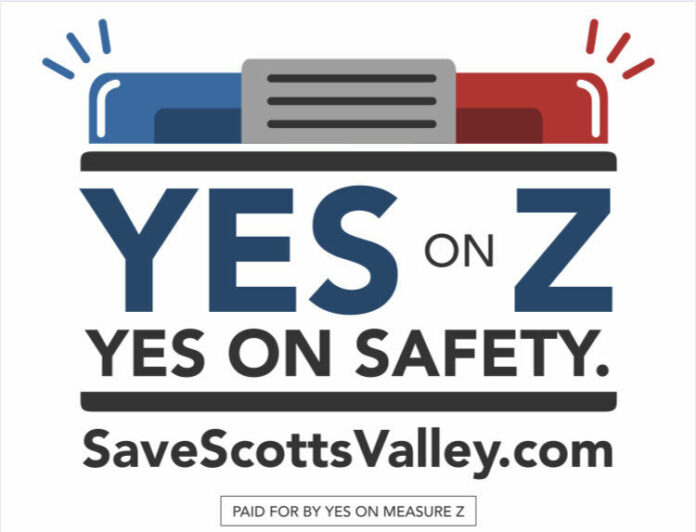To all of the readers of last week’s article about the City of Scotts Valley’s fiscal emergency and Measure Z: thank you. The City was pleased with the engagement on this article and I’m happy to provide additional information based on some questions.
First, to learn more about the City’s fiscal emergency, I encourage you to visit the City’s website: www.scottsvalley.org (scroll down to link to the fiscal emergency page). There, you’ll find a presentation on our budget, extensive Frequently Asked Questions (FAQs) and a link to the County Clerk’s official ballot information.
Now, some readers asked about property tax. Property tax is crucial to understanding the City’s financial position because the amount collected by the City is very low. In Scotts Valley, the City receives about 6.5% of total property taxes, which means that of the total $23 million collected, the City receives about $1.5 million. The statewide average percentage for city collection is nearly twice Scotts Valley’s. Our low percentage sets up the City for a structural budget disadvantage. As I liken it, Scotts Valley is behind the starting line compared to most California cities. And while there is year-over-year growth in property tax revenue, our share of that is incremental. For instance, if property taxes increased $100 for a homeowner, the City would see $6.50 from that. On the aggregate, the max 2% property tax increase allowed under Proposition 13 would bring in an estimated $30,000 more for the City. With our deficit projected between $1 and 3 million in the coming years, property tax will not materially help us close the gap. A related question I receive is, “how can we increase our low property tax percentage?” This is addressed in depth in the FAQs, but in brief, the City already took legal action to get up to its current 6.5% share and the property tax allocation is fixed as is, unless there are major statewide reforms. Due to this low share, the City is very reliant on other tax sources, especially sales and hotel taxes, which make up 50% of our budget.
Readers also asked about staffing. We have 60 budgeted full-time positions, down from 76 positions in 2004. In addition, we have about 25 temporary part-time employees but they are predominantly recreation-based positions such as recreation aides held by teens and young adults. From 5 years of furloughs (5% cuts) to modest cost of living adjustments and those offset by increased employee payments for benefits, on balance, wages have been stagnant in the past 10 years, while other public agencies around us have increased compensation. Falling behind in the hiring marketplace has drastically impacted the City’s ability to recruit and retain employees. This has contributed to the City’s effective workforce of just 50 positions with 10 vacancies. This is especially acute in our police department where we lag 20-40% behind the police officer wages offered at other local cities and the county and 50-100+% behind wages offered over the hill. We struggle to hire and keep qualified police officers due to our low pay.
The impact of retail development and hotel taxes were also queried. As mentioned before, these categories make up 50% of our budget and they are crucial to support city services. This is why the City is investing effort to facilitate the attraction of a quality replacement retailer for Kmart, fostering the development of a downtown (the Town Center project), and other work to support a healthy local economy.
Finally, there were questions about how Measure Z would work. Measure Z would repeal the existing half-cent sales tax (Measure U) and replace it with a 1¼ cent sales tax, for a net increase of ¾ of a cent. For the consumer, this means that for a $50 dinner out, it would cost 38 cents more. For a $100 purchase, it’d be 75 cents more. This ¾ of a cent is projected to raise about $2 million annually for the General Fund.
The lion’s share of the General Fund supports the police department (45% of the budget). Measure Z would forestall significant cuts across City services, and particularly in the Police Department. The Police Department was largely protected from cuts in the past, but given the severity of the fiscal emergency, reductions would also occur in police, dispatch and safety services, which will change the level of service the City can provide. Reduction plans aren’t developed but options discussed include contract services and consolidation.
For about 10 years, the City managed its budget by reducing, consolidating, contracting out, deferring and delaying expenditures. Tightening the budget has been pushed to the point where City services are threatened. The past three years were dedicated to financial planning and thorough examination of expenditures, economic development and revenues. As a result of this work, the City determined that preserving city services would require increased revenues. A sales tax measure (Measure Z) was placed on the ballot to shore up the budget and prevent major cuts to core services. Additionally, because everyone who purchases goods in Scotts Valley pays the sales tax, those who are benefitting from City services—from roads to parks to policing—help pay for these services, not just residents.
Thank you again for engaging in this critical issue,
Tina Friend, City Manager











